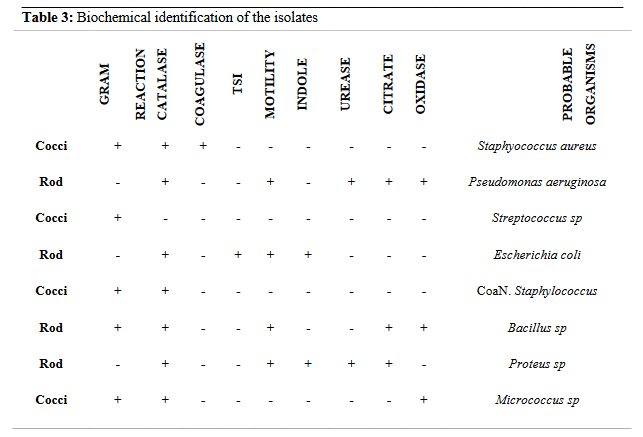Bacterial Contamination of Microphones used in places of worship in Umuahia, Abia State, Nigeria
Keywords:
Mouthpiece, Microphone, Antibiotics, Sensitivity, ResistanceAbstract
Bacteria can survive on the surface of the microscopic grooves and cracks and will go unnoticed, hence the presence of pathogenic bacteria on the user interface of microphone possesses a potential risk to vulnerable, immune compromised individuals. The aim of this study was to study the antibiotics patterns of bacteria isolated from microphones used at different churches in Umuahia, Abia State, Nigeria. 100 samples were collected from the mouthpiece and handles of the various microphones from 22 different churches in Umuahia with sterile swab sticks moistened with normal saline. A total of 85 isolates comprising of eight (8) genera were characterized from the samples. These organisms included Staphylococcus sp, Coagulase negative Staphyococcus (CoNS), Streptococcus
sp, Micrococcus sp, Bacillus sp, Proteus sp, Escherichia coli and Pseudomonas sp. Frequency distribution of the isolates was as follows Staphylococcus sp. (5.88% of total), Coagulase negative Staphylococcus (CoNS) were (11.76%), Streptococcus sp. (9.41%), Micrococcus sp. (1.18%), Bacillus sp. (3.53%), Proteus sp. (17.65%), Escherichia coli (36.47%) and Pseudomonas sp. (14.12%). The sensitivity and resistance testing of the bacteria to different antibiotics showed that all the isolates were 100% sensitive to Peflacine, Ciprofloxacin and Gentamicin. The highest percentage resistance of 42.85% was recorded for Ampicillin while the least percentage resistant of
14.28% was recorded for Ofloxacin, Streptomycin and Cefalexin each. This study showed that microphones can aid in the spread of pathogenic microorganisms between individuals and among groups at large.
References
Adamu, Y., Jairus. Y. & Ameh, J. A. (2012). “Bacterial contaminants of Nigerian currency notes and associated risk factors” Medwell Research Journals of Medical Sciences 6(1):1-6.Doi:10.3923/rjmsci.2012.1.6
Al-Ghamdi., A, Abdelmalek S, Ashshi A, Faidah H, Shukri, H. & Jiman-Fatani, A. (2011).
“Bacterial contamination of computer keyboards and mice, elevator button and shopping carts”. African Journal of Microbiology Research 5(23)3998-4003
Ashgar, S. S. & El-Said, H. M. (2012). Pathogenic bacteria associated with different public environmental sites in Meca City. Open Journal of Medical Microbiology. 2:133-137.
Bashir S.F., Muhammad H., Sani N.M & Kawo A.H. (2016). Isolation and identification of bacterial contaminants from door handles of public toilets in Federal University of Dutse, Jigawa State Nigeria. Journal of Pharmacy and Biological Sciences 11(5):53-57.
Bauer, A.W., Kirby W.M., Sherris J.C. & Truck,M. (2009). Antibiotic susceptibility testing by a standardized single disc method.American Journal of Clinical Pathology 45(4):493 – 496
Catano L, Echeverri. & Szela, C. (2012). Bacterial contamination of cloths and environmental items in a third level Hospital in Colombia. Interdisciplinary Perspectives on infectious Disease. 5:40-45.
Chandra J., Sowndarya A., Sirisha & Sharma (2014). How safe ladies handbags are: a microbioogical view. Journal of Biology and Medicine 6:212
Cheesbrough M. (2006). Medical Laboratory Manual for tropical countries volume II.Second edition, university press, Cambridge, Great Britain, 377
Datta, P. Rami, H. Chander, J. & Gupta, V. (2009) “Bacterial contamination of mobile phones of healthcare workers” Indian Journal of Medical Microbiology 27(3):279-281
EUCAST.(2009). Breakpoint tables for interpretation of MIC and Zone diameters version 1.0 .
Itah., A.T. & Ben A.E (2004). Incidence of enteric bacteria and Staphylococcus aureus in day care centers in Akwa-Ibom State, Nigeria. Southeast Asian Journal of Tropical Medicine and Public Health 35(1):202-209.
Oluduro, A.O., Ubani, E.K. & Ofoezie, I.E. (2011). Bacterial assessment of electronic hardware user interfaces in Ile-ife, Nigeria. Journal of Basic and Applied Sciences. 93:585-592
Opera, B.O., Ojo, J.O., Omonighenin, E. & Bamidele, M. (2013). Antibiotic susceptibility and plasmid profile analysis of pathogenic bacteria isolated from environmental surfaces in public toilets.Transnational Journal of Science and Technology 3(2):22-30
Reynods, K.A., Watt, P.M., Boone S.A & Gerba, C.P (2005). Occurrence of bacteria and biochemical markers on public surfaces. International Journal of Environmental Health Research 15:225-234
Roxburgh, J.C. (2005). “swabbing of ATM machines” Rentokil initial technical report, Rentokil initial PLC, London, 2005
Rusin P, Maxwell, S. & Gerba, C. (2002).Comparative surface-to-hand and fingertip to- mouth transfer efficiency of Gram positive bacteria, Gram negative bacteria and phage. Journal of Applied Microbiology.93: 585-592.













